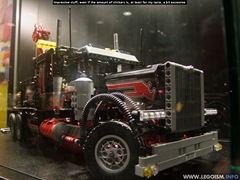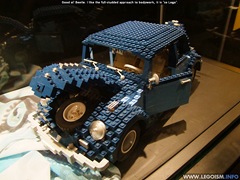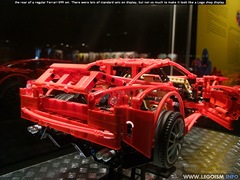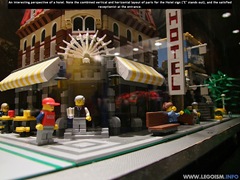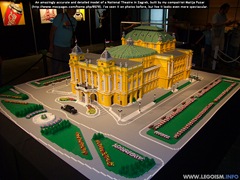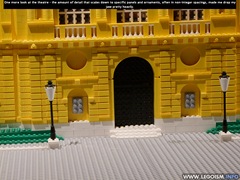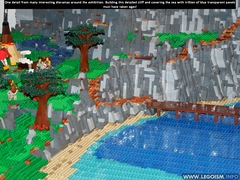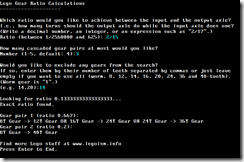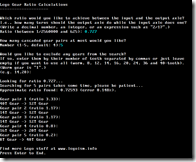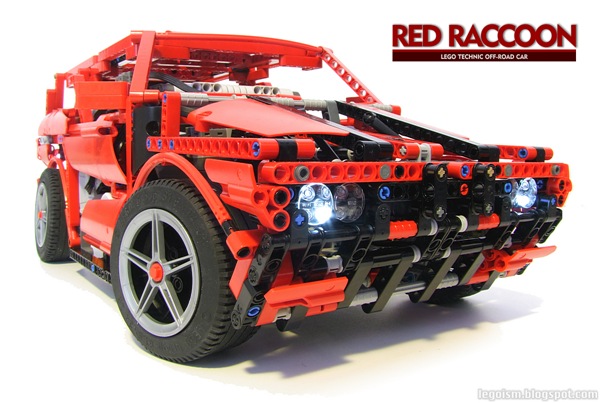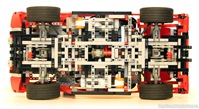A Lego exhibition roaming Europe took a stop in Zagreb, and I went to take a look about a week ago. It was nicely organized and displayed, and I took my camera along to snap a few photos. Rather than dump the entire gallery below, I've picked a few that were most interesting. (The captions are embedded in the photos.)
Sunday, May 27, 2012
Wednesday, May 23, 2012
Technic Gear Ratio Finder
A while ago, trying to build some kind of an orrery, I've had a problem of finding a combination of Technic gears that yields a very specific and precise gearing ratio. To help myself out, I've written a simple program, and hope it may help other builders facing a similar problem too.
So, basically, what it does is ask for the desired total gearing ratio, maximum number of gears involved, and the information which gears (not) to use, then display the gear combination that satisfies the input parameters, or at least comes closest possible under given limits. I have to admit it is a bit crude on the surface, but it works, is simple to use, and does not mutilate your computer with registry bloat. The full instructions and notes are packed in a Readme.txt file in the ZIP available for download, but let's just run quickly through them here.
There is no particular installation; just unpack the downloaded LegoGearCalc.zip in a folder of your choice, and start LegoGearCalc.exe. A text window should open, asking you for a first parameter: the desired gear ratio, that is, the number of turns you want the output axle to do while the input axle does exactly one full turn. This can be an integer, a decimal number, or even an expression using basic operators. E.g. entries such as 14, 0.18, 6/13, (5+2)/3*9 etc. will work fine.
Then, enter the number of gear pairs you would like to involve at most. Default is four, but you can search up to five pairs. Finally, specify any of the gears you would like to exclude from the search by entering their numbers of teeth separated by commas. Worm gear is 1. Just hit Enter (leave the entry empty) to use all Technic gears.
After a few moments at most, the program will reply with a list of gear pairs that come closest to the desired ratio, or an exact solution if there is one. Occasionally there are several ways to reach the same result, or it can be reached using less gear pairs than set as a maximum. Of course, in your system they need not be in the order from the list. Two screenshots of typical usage examples are below, with the entries typed by the user in cyan.
Many gear combinations are not easy to mesh together since they require specific spacing, but there are various methods of creating a non-integer stud distances between axle holes one can find (or better yet, invent).
(Or click here to view or download just its instruction text file.)
EXAMPLE SCREENSHOTS
Thursday, May 17, 2012
Moved to legoism.info
(Though, you don't really need to; old URL's should redirect to the new ones...)
Saturday, May 5, 2012
Red Raccoon
At last, the project that has been residing on my desk since March is finished, and here is its result ― the largest and heaviest Technic vehicle I have built so far. As expected, developing an off-road car of this size proved just as challenging as a racing car. An off-roader is more generous in terms of volume and component layout, but on the other hand, its chassis has more complex mechanical requirements to satisfy.
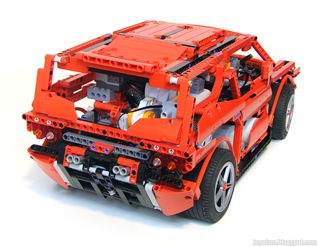 Length: 58 studs
Length: 58 studs
Width: 27 studs, 29 including tyres
Height: Variable, bodywork only: 21 studs
Weight: 2.79 kg
Suspension: Full independent
Power: Power Functions and NXT; 8 motors, 2 pairs of lights
Drive: 2x PF XL motor, 4WD
Steering: Independent front and rear steering, 1x NXT motor with Ackermann geometry each
Features:
• independently adjustable front and rear ride height
• lockable central and half-axle differentials
• 5-speed gearbox
• drive, steering, differentials, ride height and gearbox remotely controlled
• headlights and rear lights
• openable roof (to change battery packs) and bonnet
The first design stage required a development of a good half-axle component that, besides drive and steering, allows ride height adjustment and has a lockable differential via control axle. When I have settled on a working and compact design (which can be seen on the photos below), I've used it symmetrically for both front and rear axles, with some minor changes required at the front to allow the bonnet to close. The central section of the chassis, which connects these two half-axle components, houses a master differential which is linked to the output axle of the gearbox. Two NXT motors, positioned at the sides of this central chassis section, control the steering with a standard rack & pinion mechanism. I've tried to keep them as low as possible to lower the center of gravity, important for off-road stability.
 Red Raccoon is powered by two parallel PF XL motors linked into a main power axle with knob wheels, which leads to a 5-speed gearbox at the rear of the car. It is actually a variant of Sariel's linear gearbox, modified so that it doesn't require a 16L axle (whose order and delivery, I have to confess, I haven't had enough patience to wait for), for a price of being one stud longer. As all linear gearboxes do, this one needs slower speeds to shift gears reliably, but in practice it works quite well. Its important advantage is its ability to change gears using one simple motion ― moving the middle axle ― which is done with a liftarm connected to an NXT motor. That was also one of the main reasons for introuducing NXT to the car: an NXT motor can perform very precise movements, in this case in steps of 60°-30°-30°-60°, required to change gears accurately. The gearbox output axle leads, as mentioned earlier, to the master differential.
Red Raccoon is powered by two parallel PF XL motors linked into a main power axle with knob wheels, which leads to a 5-speed gearbox at the rear of the car. It is actually a variant of Sariel's linear gearbox, modified so that it doesn't require a 16L axle (whose order and delivery, I have to confess, I haven't had enough patience to wait for), for a price of being one stud longer. As all linear gearboxes do, this one needs slower speeds to shift gears reliably, but in practice it works quite well. Its important advantage is its ability to change gears using one simple motion ― moving the middle axle ― which is done with a liftarm connected to an NXT motor. That was also one of the main reasons for introuducing NXT to the car: an NXT motor can perform very precise movements, in this case in steps of 60°-30°-30°-60°, required to change gears accurately. The gearbox output axle leads, as mentioned earlier, to the master differential.
All three differentials (one master and two on the half-axles) can be locked with a single remotely controlled XL motor, which is attached to a system of clutches and arms that engage and disengage dog-rings on each of them. However, since the master differential intentionally locks more slowly than the half-axle differentials, in both ways, with good timing (matter of a few seconds) one can also lock only the half-axle or only the master differential, rather than having just the option to lock or unlock all of them together.
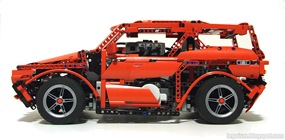 Remaining two motors have the task of adjusting the front and rear ride height. Each of their output axles is connected, through a clutch, to two cascaded worm gears that turn small 2L liftarms on which the entire suspension (with springs) rests. With their turning range of about 135°, both ends of the chassis can be raised or lowered for about two studs, while the springs themselves allow for about two studs on top of that.
Remaining two motors have the task of adjusting the front and rear ride height. Each of their output axles is connected, through a clutch, to two cascaded worm gears that turn small 2L liftarms on which the entire suspension (with springs) rests. With their turning range of about 135°, both ends of the chassis can be raised or lowered for about two studs, while the springs themselves allow for about two studs on top of that.
The lights are just standard two PF pairs, and the difficulty was not in positioning them, but rather in trying to avoid their miles of wires getting tangled into gears sticking from everywhere. The roof can be opened to replace the PF battery pack or an NXT smart brick easily. The bonnet opens too.
As one can notice on the photos, cramming all these batteries, motors and mechanics within the bodywork constraints meant there would be no room for interior decoration, even in a rather large model like this one. However, I've tried to keep the top 3-4 studs below the roof empty, to give at least some impression of this car having windows. Mentioning the bodywork, once again I went in the direction of "conventional" Technic design comprising mostly of angled beams, panels and an occasional soft axle, but leaving enough openings to reveal the mechanics inside. The bodywork is studless, as is the entire car actually, with a single exception of a rear PF infrared receiver support.
One more effect of cramming lots of equipment was a deeply asymmetric internal component layout, resulting in the car having a slight off-balance ― it leaned slightly (about one half a stud) to the right, which was solved by small readjustments of the suspension.
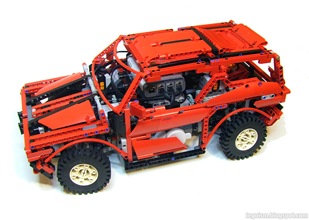 The current wheels based on Technic Medium rims with the tyres from 8880 can be replaced by the old Technic 24x43 wheels, visible on one of the photos. This change slightly increases traction on very rough terrain, but reduces performance on flat, fine surfaces. One can easily mount these old rims to the hubs with two Technic pulleys and a 3L axle with a limiter, per wheel. Being of roughly the same size and similar steering pivot point, this replacement doesn't require steering or wheelspace geometry changes.
The current wheels based on Technic Medium rims with the tyres from 8880 can be replaced by the old Technic 24x43 wheels, visible on one of the photos. This change slightly increases traction on very rough terrain, but reduces performance on flat, fine surfaces. One can easily mount these old rims to the hubs with two Technic pulleys and a 3L axle with a limiter, per wheel. Being of roughly the same size and similar steering pivot point, this replacement doesn't require steering or wheelspace geometry changes.
Since the car is controlled both through PF and NXT, I've built a controller that has a shallow cradle for my mobile phone (used for NXT control via Bluetooth) between the PF IR remotes. That altogether is quite large for a typical hand so perhaps not the most elegant way, but it works.
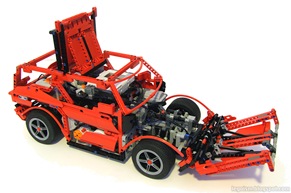 The overall performance of the car is satisfactory, and it handles sharply if both steering axles are used. Also, all the components and features of the car work reliably, and the chassis is strong enough to allow rough driving and occasional drops without any damage. However, since it follows the form of an SUV more than of a standard all-terrain car, its ground clearance may not be sufficient for really hard-core off-roading.
The overall performance of the car is satisfactory, and it handles sharply if both steering axles are used. Also, all the components and features of the car work reliably, and the chassis is strong enough to allow rough driving and occasional drops without any damage. However, since it follows the form of an SUV more than of a standard all-terrain car, its ground clearance may not be sufficient for really hard-core off-roading.
One more point that should be improved by the successor is the steering. It could be a bit more stiff ― weight of the car now produces grip for which the control components need significant force to overcome, and due to many parts involved that incur backlash, slack and bending, it's not always easy to handle. This would, though, require a significant redesign of half-axle components, in turn demanding a redesign of the entire chassis. And at least a small fake engine and a bit of interior would be nice, but would require increasing the overall size by about 15-20%. Why not?
GALLERY
BASIC VIEWS
GENESIS
VIDEO


